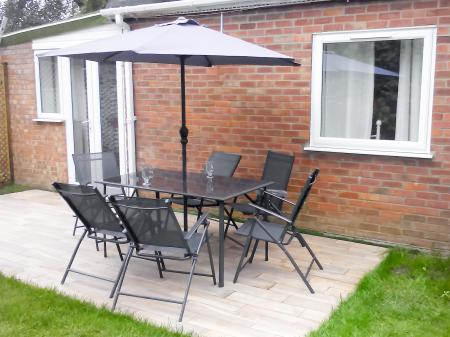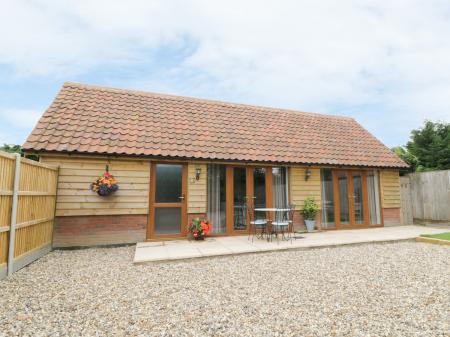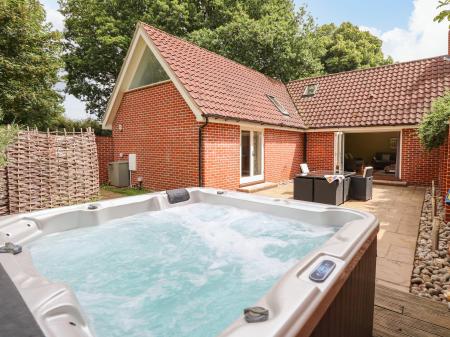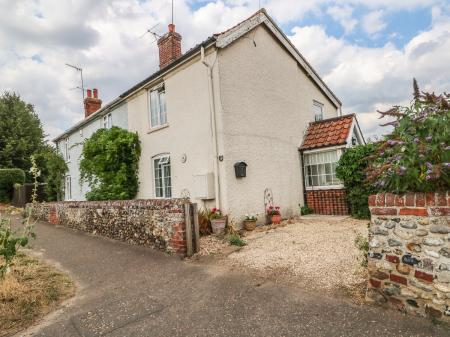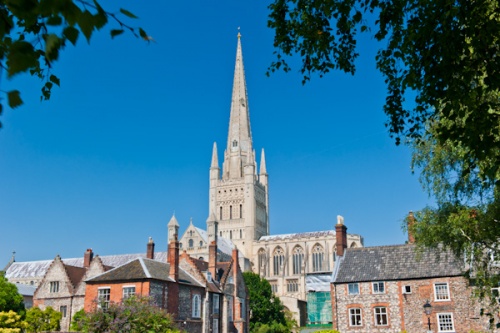
History
The first Saxon cathedral in East Anglia was established at Dunwich, on the Suffolk coast, around 630AD. By 670AD the see was divided between Dunwich and North Elmham. After the Norman Conquest the bishop's seat was transferred briefly to Thetford. Unfortunately, the Bishop and the powerful Abbot of Bury St Edmunds quarrelled.
Then in 1090, a Norman cleric by the name of Herbert de Losinga purchased the Bishopric of Thetford from Henry II, paying the king £1,900 for the post, and at the same time procuring the Bishopric of Winchester for his father. This practice of buying and selling church posts was known as simony and was a cause of great strife within the church.

According to later accounts, Herbert was swayed by the pleas of his monks, and in 1094 he journeyed to Rome to ask forgiveness of Pope Urban for his act of simony. On his return, Bishop Herbert transferred his see from Thetford to Norfolk, the largest and most important town in his see.
This move was in line with Bishop Lanfranc's 1075 decree that bishops should have their seat in the principal town in their see. Perhaps Losinga was moved by obedience, perhaps by piety, but moving his cathedra to Norwich also meant it was further away from the troublesome Abbot of Bury St Edmunds!
In 1096 Bishop Herbert began to build his new cathedral in Norwich, and founded a monastery attached to the cathedral, with the new monks coming from Canterbury.
One version of events says that building the cathedral was an act of repentance for the sinful act of buying his position. The bishop's cathedra, or throne of stone, was brought to the new building, and it can be seen today behind the altar. Norwich is one of the few cathedrals in northern Europe to have a cathedra in its original setting behind the altar.

So ambitious were Bishop Herbert's plans that the nave had only just been begun when he died in 1119. It was left to his successor, Bishop Eborard, to finish the nave, and, in turn, Bishop Eborard's successor, Bishop William de Turbe, added the tower.
In the 15th century a superb spire was added to the Norman tower, but the actual Norman work was almost untouched. The same can be said for the wonderful nave vaulting, which is one of the best features of the cathedral today; it adds a beautiful touch of later medieval style to the earlier Norman architecture but does not replace it, so we can still see today most of the 12th-century architecture of the original cathedral.
In 1272 a quarrel broke out between the prior of the cathedral and the townsfolk of Norwich when the prior tried to collect tolls for a fair. The argument escalated into violence, and the prior led a band of armed men through the city.
The enraged townsfolk threw burning brands onto the roof of the cathedral and the monastic buildings, with predictable results. Only the Lady Chapel roof was untouched by the ensuing fire; the rest of the cathedral and monastery were roofless.
The city paid a heavy fine and the church was rebuilt. Another blow fell in 1463 when lightning struck the timber spire, and the nave roof burned once more.

The Roof Bosses
When the nave roof was repaired it was rebuilt with the intricate system of vaulting we see today, with short sections of stone ribs joining at beautifully carved bosses. There are 225 bosses in the nave, arranged to tell the Biblical story from Creation to the Day of Judgement.
But that's just the nave; there are over 1000 bosses in the cathedral as a whole, and not all of them depict overtly Christian symbols. There are several carvings of the Green Man, and a multitude of strange beasts and birds.
Some are humorous, some terrifying. There are kings, nobles, peasants, musicians, Popes, and soldiers, a stonemason, an acrobat, merchants, a carpenter, and ladies with fanciful headdresses. In short, there is a wonderful cross-section of medieval society.
The Norwich bosses have with good reason been called 'one of the greatest hidden glories of medieval art' (Martial Rose, Stories in Stone, 1997).
One unusual feature for England is the rounded apse behind the high altar. The view of the east end, with the choir and rounded apse rising up through the Norman triforium and arcading to the 15th-century ceiling is one of the most stunning sights in any English building.

The Cloisters
Beside the main cathedral building are the cloisters, enclosing a central open space. The cloisters date from the period 1297-1430, and once more the vaulting and roof bosses are superb - with the added advantage that the roof is much closer and you can more easily see the bosses in detail!
Bosses on the south and west walks show scenes from the Book of Revelations, while the east and north walks depict the life of Christ. The detail in these carved bosses is simply stunning.
Cathedral Highlights:
West Window
Dating to the 15th century, the west window is set with 19th-century glass depicting the lives of Moses and Christ.
The Choir
The choir stalls date to the 15th century and many are decorated with medieval misericord carvings (a misericord is literally a 'mercy seat' to support clergy standing during long services). The carvings represent both secular and religious themes. One seat is carved with a decidedly secular misericord of the Norwich City Football Club symbol!

The Founders Tomb
Standing before the high altar is the tomb of Bishop Herbert de Losinga (d. 1119), who began the building of the cathedral in 1096. The stone slab dates to 1682 and replaces the original 12th-century memorial. Nearby is a bas relief carving commemorating the 900th anniversary of the building.
Goldwell Chantry Chapel
Established by Bishop Goldwell, who built the spire and the presbytery vaulting. One reminder of Norwich's turbulent past is a Civil War musket ball, still stuck in the wall.
Jesus Chapel
A semi-circular chapel with 12th-century blind-arcading along the wall. The arcades and column capitals retain medieval wall paintings, and the stone altar slab is a rare Norman survivor.

St Andrews Chapel
Look for the 14th-century painted panel behind the altar.
The Erpingham Window
Named in honour of Sir Thomas Erpingham, who fought at the Battle of Agincourt in 1415. Here are gathered the best pieces of the cathedral's medieval stained glass.
The Bishop's Cathedra
Behind the high altar at the top of a set of steps is the Bishop's throne. There is a wooden seat over two sections of carved stone, which formed part of the original cathedra and are probably over 1200 years old.
The Cloisters
The largest monastic cloisters in England. Among the medieval chambers you can visit are the monks dormitory, refectory (dining room), infirmary, and guest quarters. The main passage between the cloisters and cathedral is Prior's Door, a 14th-century doorway carved with Biblical figures.

Edith Cavell Grave
Just outside the south door is the grave of Edith Cavell, executed for helping Allied soldiers to escape from occupied Belgium during WWI. A large memorial statue to Cavell stands just outside the cathedral precinct facing Tombland.
The Despenser Reredos
Located behind the altar in the St Luke's Chapel is a superb painted altarpiece. This was a gift to the cathedral of Bishop Despenser, given in gratitude for the failure of the 1381 Peasant's Revolt. It is among the finest pieces of late 14th-century art in Europe, and depicts in 5 panels scenes from the Crucifixion and Resurrection of Christ. Also in the chapel is a superbly carved late medieval octagonal font, brought here from St Mary in the Marsh church.
St Felix Statue
Just outside St Luke's chapel a large stone statue is set into a niche. The statue probably dates to the late 11th century and is thought to represent St Felix, one of the first Christian missionaries to East Anglia.
The Font
Decidedly unusual - the font is a large copper container originally used in the manufacture of chocolate by a local factory. When the factory closed the copper vat was presented to the cathedral for use as a baptismal font.
CATHEDRAL HIGHLIGHT PHOTOS






The Cathedral Precinct
The cathedral stands within a walled precinct, or enclosure, with high walls pierced by large gateways. Within the precinct are a wealth of historic buildings and other interesting bits and bobs aside from the actual cathedral building. Here are some of the highlights you can find within the precinct:
Ethelbert Gate
Leading from the southern end of Tombland into the cathedral precinct, this is the most beautifully decorated gateway, with a very early flint flushwork design. The original gate was built in the 12th century, but what we see today is almost entirely from a rebuilding in 1320. The ornately carved upper floor once held a small chapel.
Erpingham Gate
Dated to 1420-35, this elaborate entrance stands opposite the cathedral's west front and was built as part of a single, unified architectural design with the west front. The gateway consists of a single, vaulted passage. Just inside the Erpingham Gate is the ...

Carnary Chapel
Built to serve a chantry founded by Bishop Sampson in 1316. The original chapel stands over an undercroft used as a charnel house (bone storage area).
Deanery and Prior's Hall
The hall of late 13th century private dwelling for the prior still stands, though much altered.
Herb Garden
Located very close to the original monastic herb garden, this delightful small garden includes many plants that the monks would have used for medicines, cooking, and simply to strew on the floor! Laid out with an eye to recreating a traditional 'physic garden', with a pair of knot gardens defined by low box hedges. Open daily in the grounds of Emmaus House.
Monastic Ruins
A section of ruined walls and broken arches is all that remains of the infirmary built for the monks. The ruins date to the last quarter of the 12th century. They were repaired in 1896 and stand behind a protective iron railing in the parking area by the main south entrance.
FACTS AND FIGURES
- The cathedral is 461 feet long and 72 feet wide
- The transepts are 177 feet long
- The nave stands 69 feet high
- The spire is the second tallest in England at 315 feet
- There are 6655 pipes in the organ
- 1106 carved medieval roof bosses
Summing up
We've visited Norwich Cathedral on several occasions now, and each time we visit I am struck anew by how beautiful it is. The cathedral precinct, though it can be crowded at times, is a relative oasis, and it is filled with attractive historical buildings. The cathedral itself is one of the finest medieval buildings of any description in England. The cloisters are superb, and the combination of Norman and late medieval architecture in the church itself is stunning.
CATHEDRAL PRECINCT HIGHLIGHTS







